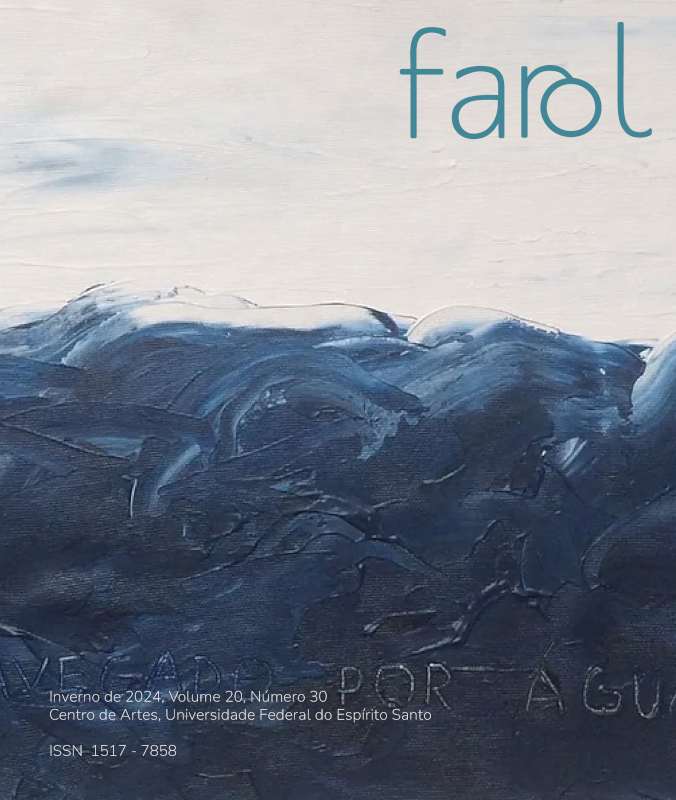Watching and Making Films with Young People from the Santa Cruz Neighborhood-RJ
Creation Experiences with REALIZACINE
DOI:
https://doi.org/10.47456/rf.v20i30.43049Keywords:
Arte Educação, Cinema e Educação, Cinema de Periferia, Juventudes, Juventudes periféricasAbstract
This paper aims to present the creative experiences mobilized since Realizacine, a cultural project for introducing cinema and audiovisual media to children and young people from the Santa Cruz neighborhood, in the west zone of the city of Rio de Janeiro. To this end, we make some notes about the plurality of these young people and their ways of occupying this territory, presenting audiovisual creation as a possibility of redefining narratives.
Downloads
References
ABRAMO, Helena Wendel. Considerações sobre a tematização social da juventude no Brasil. Revista brasileira de educação, n. 05-06, p. 25-36, 1997. Disponível em: http://educa.fcc.org.br/pdf/rbedu/n05-06/n05-06a04.pdf. Acesso em: 18 jun 2023.
ALMEIDA, Renato Souza de. Juventude, direito à cidade e cidadania cultural na periferia de São Paulo. Rev. Inst. Estud. Bras., São Paulo , n. 56, p. 151-172, Junho 2013 . Disponível em: http://www.scielo.br/scielo.php?script=sci_arttext&pid=S0020-38742013000100007&lng=en&nrm=iso. Acesso em 23 jan. 2021.
ARRUDA, Daniel Péricles. Cultura Hip-Hop e Serviço Social: a arte como superação da invisibilidade social da juventude periférica. Rev. katálysis, Florianópolis, v. 23, n. 1, p. 111-121, abril 2020. Disponível em: http://www.scielo.br/scielo.php?script=sci_arttext&pid=S1414-49802020000100111&lng=en&nrm=iso. Acesso em 15 Jan. 2021. Epub Feb 27, 2020. https://doi.org/10.1590/1982-02592020v23n1p111.
BRASIL. Lei nº 12.852, de 5 de agosto de 2013. Institui o Estatuto da Juventude e dispõe sobre os direitos dos jovens, os princípios e diretrizes das políticas públicas de juventude eo Sistema Nacional de Juventude-SINAJUVE. Diário Oficial da União, p. 1-1, 2013.
BRASIL (2023). Lei nº 14.533, de 11 de janeiro de 2013. Institui a Política Nacional de Educação Digital e altera as Leis nºs 9.394, de 20 de dezembro de 1996 (Lei de Diretrizes e Bases da Educação Nacional), 9.448, de 14 de março de 1997, 10.260, de 12 de julho de 2001, e 10.753, de 30 de outubro de 2003. Disponível em: https://www.planalto.gov.br/ccivil_03/_Ato2023-2026/2023/Lei/L14533.htm. Acesso em: 25 nov. 2023.
BRASIL (2010). Instituto Brasileiro de Geografia e Estatística. Pesquisa Nacional por Amostra de Domicílios 1992-2012. Rio de Janeiro: IBGE.
CONJUVE (2021). Juventudes e a Pandemia. Brasília: DF. Disponível em: https://atlasdasjuventudes.com.br/wpcontent/uploads/2021/08/JuventudesEPandemia2_Relatorio_Nacional_20210702.pdf. Acesso em: 18 jun 2023.
DAYRELL, Juarez. A escola" faz" as juventudes? Reflexões em torno da socialização juvenil. Educação & Sociedade, v. 28, p. 1105-1128, 2007. Disponível em: https://www.scielo.br/j/es/a/RTJFy53z5LHTJjFSzq5rCPH/?format=pdf&lang=pt. Acesso em: 01 out. 2022.
DA CONCEIÇÃO, Daniel Machado; MEZZAROBA, Cristiano; DOS SANTOS, Marcos Rogério. As juventudes na mídia durante a pandemia COVID-19: compreender para educar. Cadernos do Aplicação, v. 34, n. 1, 2021. Disponível em: https://seer.ufrgs.br/index.php/CadernosdoAplicacao/article/view/111195/61447. Acesso em: 18 jun. 2023.
D’ANDREA, Tiarajú Pablo. A formação dos sujeitos periféricos: cultura e política na periferia de São Paulo. São Paulo: FFLCH, 2013. Disponível em: https://edisciplinas.usp.br/pluginfile.php/5787144/mod_resource/content/1/Tese%20A%20Forma%C3%A7%C3%A3o%20dos%20Sujeitos%20Perif%C3%A9ricos.pdf. Acesso em: 18 jun. 2023.
DIÓGENES, Glória. Cidade, arte e criação social: novos diagramas de culturas juvenis da periferia. Estudos avançados, v. 34, p. 373-390, 2020. Disponível em: https://www.scielo.br/j/ea/a/FhF4HRhNzQsRcpfzSZpGKfd/abstract/?lang=pt. Acesso em: 18 jun. 2023.
FLUMINENSE, Casa. Mapa da Desigualdade, Região Metropolitana do Rio de Janeiro. 2020. Rio de Janeiro. Disponível em: https://casafluminense.org.br/mapa-da-desigualdade/. Acesso em: 18 jun. 2023.
FONTES, Jean Vitor Alves; TAKEITI, Beatriz Akemi; CORREIA, Ricardo Lopes. Contra-colonialidades nos coletivos juvenis: uma experiência com o “Cultura Zona Oeste” no Rio de Janeiro. PragMATIZES-Revista Latino-Americana de Estudos em Cultura, v. 12, n. 22, p. 137-162, 2022. Disponível em: https://periodicos.uff.br/pragmatizes/article/view/51063/31123. Acesso em: 18 jun. 2023.
FOUCAULT, Michel. História da Sexualidade I: A vontade de saber. Tradução de Maria Thereza da Costa Albuquerque e J.A. Guilhon Albuquerque. Rio de Janeiro: Edições Graal, 2001a.
FOUCAULT, Michel. Microfísica do Poder. Organização e tradução de Roberto Machado. Rio de Janeiro: Edições Graal, 2001b.
FOUCAULT, Michel. Vigiar e punir: nascimento da prisão. Tradução de Raquel Ramalhete.
Petrópolis, RJ: Vozes, 2002.
GUEDES, Marta Cardoso. O cinema na escola do Vidigal: elaboração de memória e luta da favela. Tese de Doutorado. Programa de Pós-Graduação em Educação. Universidade Federal do Rio de Janeiro, 2021.
LOUREIRO, Bráulio. Formação política via autoeducação no movimento hip-hop: experiências de rappers ativistas no Brasil. Educação, n. 44, 2019. Disponível em: https://www.redalyc.org/journal/1171/117158942060/117158942060.pdf. Acesso em: 18 mar. 2022.
MIGLIORIN, Cezar. O que é um coletivo. In: BRASIL, André (Org.) Livro Teia 2002-2012, 1a edição, Editora: Teia, Belo Horizonte, 2012, p. 307 – 313.
MOREIRA, Leonardo Cesar Alves; D’ARROCHELLA, Márcio Luiz Gonçalves; SILVA, Ynara Noronha; de Almeida, Pedro Cupolillo . Sujeitos periféricos e coletivos culturais: pertencimento, participação e política no bairro de Santa Cruz - RJ. Publicatio UEPG: Ciências Sociais Aplicadas, v. 31, p. 1-14, 2023. Disponível em: https://revistas.uepg.br/index.php/sociais/article/view/21093/209209218120. Acesso em: 30 jun. 2024.
MOREIRA, Leonardo Cesar Alves; ALMEIDA, Pedro Cupolillo de. Cinema e educação na perspectiva da igualdade de inteligências: reflexões sobre ver e fazer filmes como construções de um comum para as produções curriculares com estudantes da educação básica. Série-Estudos, v. 28, n. 63, p. 311-335, 2023. Disponível em: http://educa.fcc.org.br/pdf/sest/v28n63/1414-5138-sest-28-63-0311.pdf. Acesso em: 30 jun. 2024.
OLIVEIRA, Victor Hugo Nedel; DOS SANTOS, Andreia Mendes. Juventudes contemporâneas e a pandemia da covid-19: constituindo novas formas de ser e estar jovem. Revista Hominum, 2021. Disponível em: https://meriva.pucrs.br/dspace/bitstream/10923/21873/2/JUVENTUDES_CONTEMPORNEAS_E_A_PANDEMIA_DA_COVID19_CONSTITUINDO_NOVAS_FORMAS_DE_SER_E_ESTAR_JOVEM.pdf. Acesso em: 18 jun. 2023.
OLIVIERI, Cristiane; NATALE, Edson (Ed.). Guia brasileiro de produção cultural: ações que transformam a cidade. Edições Sesc, 2016.
SILVA, Maria das Graças Pereira et al. Juventudes e educação: O uso das tecnologias como ferramenta de aprendizagem em tempos de pandemia da covid-19. Cadernos do Aplicação, v. 34, n. 1, 2021. Disponível em: https://seer.ufrgs.br/index.php/CadernosdoAplicacao/article/view/111266/61510. Acesso em: 18 jun. 2023.
TAKEITI, Beatriz Akemi; VICENTIN, Maria Cristina Gonçalves. Juventude (s) periférica (s) e subjetivações: narrativas de (re) existência juvenil em territórios culturais. Fractal: Revista de Psicologia, v. 31, p. 256-262, 2019. Disponível em: https://www.scielo.br/j/fractal/a/zdCRzXcBsFhkQvkDrbLTp3s/?format=html. Acesso em: 19 mar. 2022.
Downloads
Published
How to Cite
Issue
Section
License
Copyright (c) 2024 Daniele Gomes, Leonardo Cesar Alves Moreira

This work is licensed under a Creative Commons Attribution-NonCommercial-ShareAlike 4.0 International License.
The authors of works submitted to Revista Farol authorize their publication in physical and electronic media, solely for academic purposes, and may be reproduced as long as the source is cited. They attest to their originality, authorship and originality.





